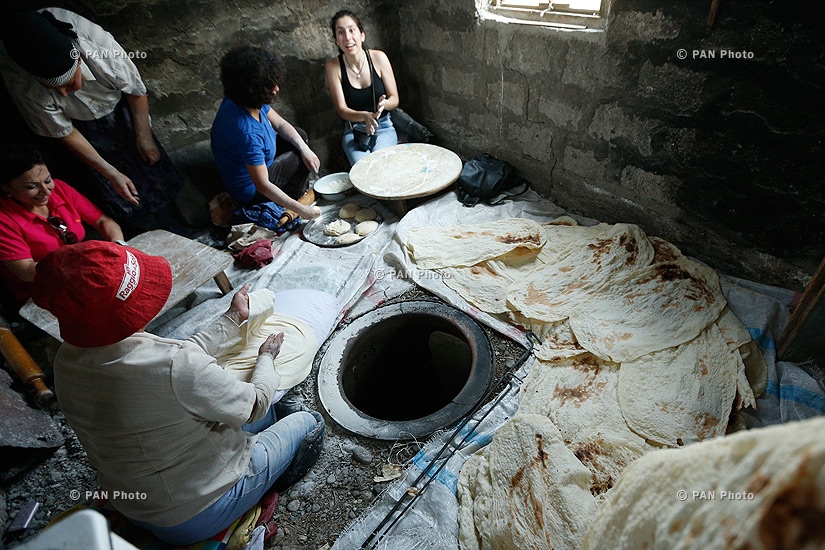Who doesn’t know about Armenian lavash? Everybody knows Armenian lavash. Just s bread. Who doesn’t eat bread? Everyone eats bread. It’s a very simple story: here are the flour, water and stove.
But few years ago, this “ordinary bread” was registered in the list of the intangible cultural heritage of mankind. What is so special about it?

Lavash is a food. But in Armenia it is the main meal. The whole Armenian table revolves around it. It wraps everything and anything that can get into your hands. They even say about children, “I will wrap you into lavash and eat!”, meaning that those are so cute, that it is not possible to resist. Any product that has been wrapped into lavash is called “brtuch”. All the rest is called “khash”, because only khash cannot be wrapped in it. Whoa, who said that? To wrap the khash in lavash, you need to crush lavash in the khash; and then what you have, you can wrap in lavash or at least take with lavash.

Lavash is a history. As soon as the mortar, grain and hearth appeared in the cultural of an old man, the first bread was born. And although this process has been changed by time and experience and even if it lost rituals and adaptations, in Armenia they still bake with traditions as it was thousands of years ago. That is why the Armenian lavash is registered in UNESCO list as a cultural phenomenon, as a dish. Its cooking, meaning and appearance contain the nation’s cultural code. Lavash has its noticeable place in the global historical events of the region: according to the legend, it was lavash that kept St. Gregory the Illuminator alive for thirteen years while he was in the well in Artashat. According to another legend, due to lavash, one of the Armenian kings, Aram, defeated Assyrian regent Nebuchadnezzar, who had captivated him. The thinness and shape of this bread allowed to transfer it secretly to Aram and support the captive king.

Lavash is beautiful. Women bake it, and despite the labor-intensiveness, their harmonious work seems to be a dance: the dimensions and ease of movement, their rhythm and character, the flight from hand to hands, the circle of shadows around the tonir – like the worship of a generous god, who throws out from the fire thin petals bread in response.

Lavash is a family, a community. It is good to make pancakes alone, but the traditional Armenian lavash requires teamwork. In this teamwork they participate not only “dancing” women, but also men. To build a furnace (tonir) deepened into the ground, make cushions to place the dough, bend iron hooks to remove the baked sheets; all this is a man’s things to do. To knead the dough, sing a song for it, bow to a red-hot oven is a woman’s thing. All the roles are strictly distributed. Traditionally, the oldest woman of the family kneads the dough, young women roll it out to transparency, and the experienced and strong mistress sits over the hot tint. She pulls the dough onto the pillow, puts it into the oven, slams it to the fire wall, and half a minute later picks up the finished lavash with a hook. Then it lies down to have a rest on the table, under the towel or burns greedy little hands, impatient baby lips, since children are impatient to eat new-baked lavash.

Lavash is life. This amazing bread, as well as many other traditional Armenian products, has one important and even fateful peculiarity: the long shelf life. There are lots of black pages in the history of the Armenian people, and who knows, would it be possible to survive, if there were no that modest lavash, flour and water, which will be eatable even after half a year, if it is dried. They lay it out, hang out the ready sheets, then collect them into fragile high stacks and cover with a clean cloth, like a sleeper. It is just enough to drizzle dried lavash with water and hold under a towel for half an hour and it will become soft again, ready for feats and brduchs (traditional rolls).

Lavash is a home and homeland. Travelers and exiles take it with them on a road trip, take over the seas as a little part of their history. The aroma of freshly baked lavash reminds you of your childhood: lavash is the smell of mother and grandmother, and maybe, the contrary, mother and grandmother smell like lavash. Lavash is placed on the shoulders of newlyweds, like a mantle protecting from poverty and adversity. With this precious burden they enter the house together for the first time. She wraps “her sorrow” in lavash, the heroine of the fairy tale “Magic Lavash”. With them it is almost eatable, she says to her son. And, imagine, it was lavash that brought him back home from a long journey of persuit of happiness, because happiness is to grow cereal and make bread in the homeland.
photo: TRAVEL-ARMENIA, www.panarmenian.net